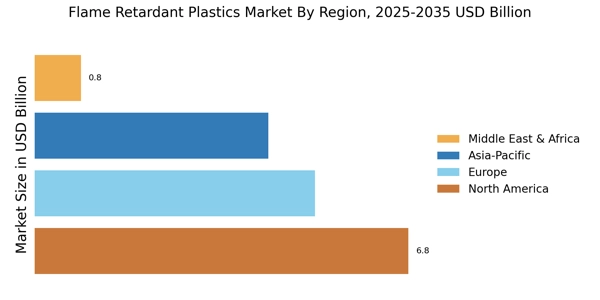Innovations in Material Science
The Flame Retardant Plastics Market is witnessing a wave of innovations in material science, leading to the development of more effective and environmentally friendly flame retardant solutions. Researchers are exploring bio-based and halogen-free alternatives that offer superior fire resistance without compromising environmental integrity. This shift is likely to attract a broader customer base, particularly among environmentally conscious consumers and industries. By 2025, it is projected that these innovative materials could capture up to 20% of the flame retardant plastics market, indicating a transformative phase for the industry.
Expansion of Construction Activities
The Flame Retardant Plastics Market is significantly impacted by the expansion of construction activities worldwide. As urbanization accelerates, the demand for flame retardant materials in building and construction applications is on the rise. Flame retardant plastics are increasingly used in insulation, wiring, and structural components to enhance fire safety in residential and commercial buildings. In 2025, the construction sector is expected to contribute approximately 35% to the overall demand for flame retardant plastics. This trend underscores the critical role of fire safety in modern construction practices, suggesting a robust growth outlook for the industry.
Increasing Demand from Automotive Sector
The Flame Retardant Plastics Market is experiencing a notable surge in demand from the automotive sector. As manufacturers strive to enhance vehicle safety, the incorporation of flame retardant plastics has become essential. These materials not only provide fire resistance but also contribute to weight reduction, which is crucial for fuel efficiency. In 2025, the automotive industry is projected to account for approximately 25% of the total flame retardant plastics consumption. This trend is driven by stringent safety regulations and consumer preferences for safer vehicles, indicating a robust growth trajectory for flame retardant plastics in automotive applications.
Rising Awareness of Fire Safety Standards
The Flame Retardant Plastics Market is bolstered by the increasing awareness of fire safety standards across various sectors. Industries such as construction, transportation, and consumer goods are adopting flame retardant materials to comply with stringent regulations aimed at enhancing fire safety. In 2025, it is anticipated that the demand for flame retardant plastics will rise by 15% due to these regulatory pressures. This heightened focus on safety not only protects lives but also mitigates financial losses associated with fire incidents, thereby driving the market forward.
Growth in Electronics and Electrical Applications
The Flame Retardant Plastics Market is significantly influenced by the expansion of the electronics and electrical sectors. With the proliferation of electronic devices, the need for materials that can withstand high temperatures and resist ignition is paramount. Flame retardant plastics are increasingly utilized in components such as circuit boards, connectors, and housings. In 2025, the electronics sector is expected to represent around 30% of the market share for flame retardant plastics. This growth is propelled by advancements in technology and the rising demand for consumer electronics, suggesting a sustained upward trend in the industry.


















Leave a Comment